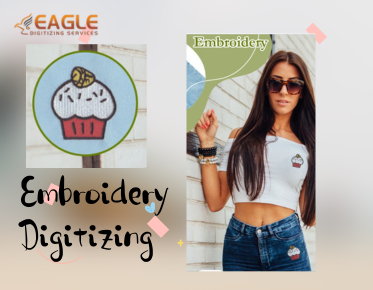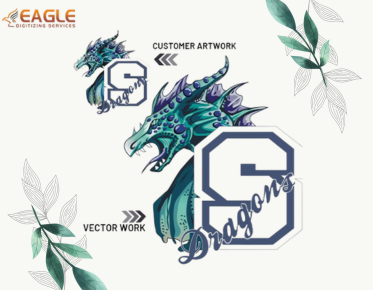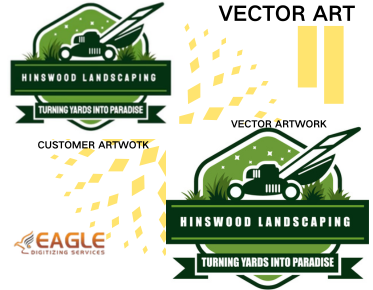Step-by-Step Guide to Digitizing Images for Embroidery
Embroidery has evolved from hand-stitched heirlooms to machine-driven
masterpieces, thanks to the wonders of technology. Digitizingan image for embroidery is a game-changer, allowing you to turn any
graphic into a stitchable work of art. Whether you're a hobbyist or a
professional, understanding the intricacies of this process can elevate your
embroidery projects to new heights.
Why
Digitizing an Image for Embroidery is a Game-Changer
Digitizing transforms a simple image into a complex set of
instructions that an embroidery machine can follow. This means you can take a
favorite photo, logo, or custom design and convert it into a detailed
embroidered piece. It’s a way to personalize items, create unique gifts, and
bring artistic visions to life with precision and repeatability.
The
Basics of Embroidery Machine Files
Embroidery machines read files that tell them how to move the
needle, where to place stitches, and what colors to use. These files contain
intricate details about stitch types, directions, and densities. Understanding
these basics is crucial for successful digitization.
Understanding
Different File Formats
Different embroidery machines require different file formats. Common
formats include DST, PES, JEF, and EXP, each compatible with specific brands or
types of machines. Knowing which format your machine uses ensures your designs
are read and executed correctly.
The
Importance of Quality Digitization
Quality digitization is the backbone of beautiful embroidery. Poorly digitized images can lead to distorted designs, broken threads, and wasted materials. Investing time in learning and practicing digitization can dramatically improve your results.
Preparing
Your Image for Digitization
Choosing the Right Image
Not all images are created equal when it comes to digitization.
High-contrast, simple designs with clear outlines tend to work best. Avoid
overly intricate images that might not translate well into stitches.
Image Resolution: How High is
High Enough?
Higher-resolution images are essential for capturing detail. Aim for
at least 300 DPI (dots per inch) to ensure your design is sharp and clear.
Lower resolutions can result in pixelated, unrefined embroideries.
Cleaning Up Your Image: Removing
Backgrounds and Noise
Before digitizing, clean up your image by removing any unnecessary
backgrounds and noise. This can be done using photo editing software. A clean
image ensures that the digitizing software focuses on the essential parts of
your design.
Selecting
Software for Digitization
Top Software Options for
Beginners
Beginners might find software like Hatch Embroidery or SewArt
accessible due to their intuitive interfaces and helpful tutorials. These
programs are designed to make the digitization process straightforward and less
intimidating.
Advanced Software for Pros
For more advanced users, software like Wilcom Embroidery Studio or
Brother PE-Design offers a comprehensive suite of tools. These programs allow
for intricate design work, including advanced stitch editing and customization.
Free vs. Paid: What’s the Difference?
Free software often has limited features and can be less user-friendly. Paid software, while an investment, typically offers extensive capabilities, better support, and regular updates, which are crucial for professional-quality results.
Step-by-Step
Guide to Digitizing an Image
Importing Your Image into the
Software
Start by importing your chosen image into your digitizing software.
Most programs support common image formats like JPEG, PNG, or BMP.
Setting Up Your Workspace
Adjust your software's workspace to match the dimensions of your
embroidery hoop and the scale of your design. This ensures your design will fit
perfectly when stitched.
Basic Tools You'll Need
Familiarize yourself with basic tools like the pen tool, node editor,
and stitch type selector. These will be your primary instruments in
transforming your image into embroidery.
Creating
the Outline of Your Design
Using the Pen Tool for Precision
The pen tool is essential for tracing the outline of your design. It allows
for precise control, helping you to create smooth, accurate paths that your
machine will follow.
Adjusting Node Points for Smooth
Curves
After tracing, refine your lines by adjusting the node points. Smooth
curves ensure that the final embroidery looks professional and polished.
Filling
in the Details
Choosing the Right Stitches
Different stitch types serve different purposes. Satin stitches are
great for borders, while fill stitches cover larger areas. Choose stitches that
enhance the texture and depth of your design.
Adjusting Stitch Density
Stitch density affects the thickness and coverage of your embroidery.
Too dense, and the fabric might pucker; too sparse, and the design could look
incomplete. Find a balance that works for your design and fabric.
Color Selection and Management
Select thread colors that closely match your design. Most software
includes color charts from major thread manufacturers, making it easier to
visualize the final result.
Adding
Text to Your Design
Choosing the Right Font
Fonts can add a personal touch to your embroidery. Choose fonts that
are readable and complement your design. Avoid overly intricate fonts that
might not stitch well.
Placing and Aligning Text
Place your text strategically within your design. Use alignment tools
to ensure your text is centered and spaced correctly, giving your embroidery a
professional look.
Applying
Special Effects
Incorporating Texture with
Stitches
Use different stitch types to add texture and dimension to your
design. For example, blending fill stitches can create a gradient effect,
adding depth to your embroidery.
Using Appliqué for Added
Dimension
Appliqué involves stitching a piece of fabric onto your main fabric,
creating a layered effect. This technique adds dimension and can make parts of
your design stand out.
Testing
and Refining Your Digitized Design
Running a Test Stitch
Before finalizing, run a test stitch on scrap fabric to assess stitch
quality, tension, and overall appearance. Make adjustments as needed to
optimize the final embroidery output.
Identifying and Fixing Common
Issues
Address common issues such as thread breaks, tension problems, or misaligned stitches during testing. Troubleshoot by adjusting settings or refining digitized paths.
Finalizing
Your Embroidery File
Saving Your File in the Correct
Format
Save your completed embroidery file in a compatible format (DST, PES,
EXP, etc.) suitable for your embroidery machine's requirements.
Checking Compatibility with Your
Embroidery Machine
Ensure your saved file is compatible with your specific embroidery
machine model. Verify file settings and transfer methods for seamless machine
integration.
Tips
for Successful Digitization
Keeping Designs Simple and Clean
Simplify complex designs to ensure clarity and ease of digitization.
Focus on key elements to maintain stitch quality and reduce production
challenges.
Avoiding Overly Complex Designs
Complex designs may require more time and expertise to digitize
effectively. Start with simpler designs to build confidence and skill in
embroidery digitization.
Understanding Thread Types and
Their Impact
Familiarize yourself with different thread types (polyester, rayon,
metallic, etc.) and their effects on embroidery appearance, durability, and
texture.
Advanced
Techniques for Professional Results
Creating 3D Puff Embroidery
3D puff embroidery uses foam to create raised, textured
designs. This technique adds a tactile element to your embroidery, making it
stand out.
Using Gradient Fills
Gradient fills blend colors smoothly, creating a gradient effect in
your embroidery. This advanced technique adds depth and interest to your
designs.
Combining Multiple Images into
One Design
Combine elements from multiple images to create a unique design. This approach allows for more creativity and complexity in your embroidery projects.
Troubleshooting
Common Problems
Thread Breaks and Tension Issues
●
Adjusting Tension Settings: Fine-tuning tension
settings on your embroidery machine ensures threads feed smoothly. Balancing
upper and bobbin thread tensions prevents breaks and enhances stitch
consistency.
●
Using Quality Threads: Choosing high-quality threads
reduces breakage risks. Threads designed for embroidery offer durability and
smoother performance, which is crucial for uninterrupted stitching.
Misalignment and Registration
Issues
●
Checking Hoop Alignment: Properly aligning the
embroidery hoop before stitching prevents misalignment. Secure fabric tension
and position within the hoop to maintain design integrity.
●
Adjusting Machine Settings: Calibrating machine
settings like speed and needle position minimizes misalignment. Ensure settings
match fabric thickness and design complexity for precise stitching.
Skipped Stitches
●
Checking Needle and Thread Compatibility: Verify
needle size and type compatibility with thread weight and fabric. Sharp needles
and correct thread thickness prevent skipped stitches and maintain uniformity.
●
Adjusting Needle Type and Size: Using appropriate
needle types (e.g., ballpoint for knits) and sizes prevents fabric damage and
skipped stitches. Regularly replace needles to maintain optimal performance.
Puckering and Pulling Fabric
●
Choosing the Right Stabilizer: Selecting suitable
stabilizers based on fabric type and design complexity reduces puckering.
Stabilizers provide structural support and prevent fabric distortion.
●
Adjusting Design Density: Reducing stitch density
in dense areas minimizes fabric pull. Balancing stitch density across the
design maintains fabric smoothness and embroidery quality.
Fading or Blurring of Details
●
Optimizing Design for Clarity: Enhance design
clarity by adjusting satin stitch settings. Optimal stitch lengths and tensions
preserve intricate details and prevent blurring over time.
●
Adjusting Satin Stitch Settings: Fine-tuning
satin stitch parameters (e.g., density and tension) sharpens design edges.
Experiment with stitch variations to achieve desired visual effects.
Hooping Issues
●
Proper Hooping Techniques: Master proper hooping
techniques for stable embroidery. Even fabric tension and secure hooping
prevent shifting and maintain design alignment.
●
Using Correct Hoop Size: Selecting appropriate
hoop sizes minimizes fabric distortion. Choose hoops that match design
dimensions for precise stitching and minimal rehooping.
Tools
and Resources for Ongoing Learning
Online Tutorials and Courses
There are countless online resources to help you improve your
digitizing skills. Websites like YouTube, Craftsy, and Udemy offer tutorials
and courses for all skill levels.
Community Forums and Groups
Join forums and social media groups where you can share your work, ask
questions, and learn from others. Communities like EmbroideryLibrary and
r/MachineEmbroidery are great places to start.
Books and Manuals
Invest in books and manuals dedicated to embroidery digitization.
These resources provide in-depth knowledge and can serve as valuable
references.
Digitizing
an image for embroidery is both an art
and a science. By mastering the techniques and tools available, you can
transform any image into a stunning embroidered design. Start simple, practice
often, and don’t be afraid to experiment. The world of embroidery digitization is vast and full of creative possibilities. Embrace the
journey and watch your designs come to life, stitch by stitch.



